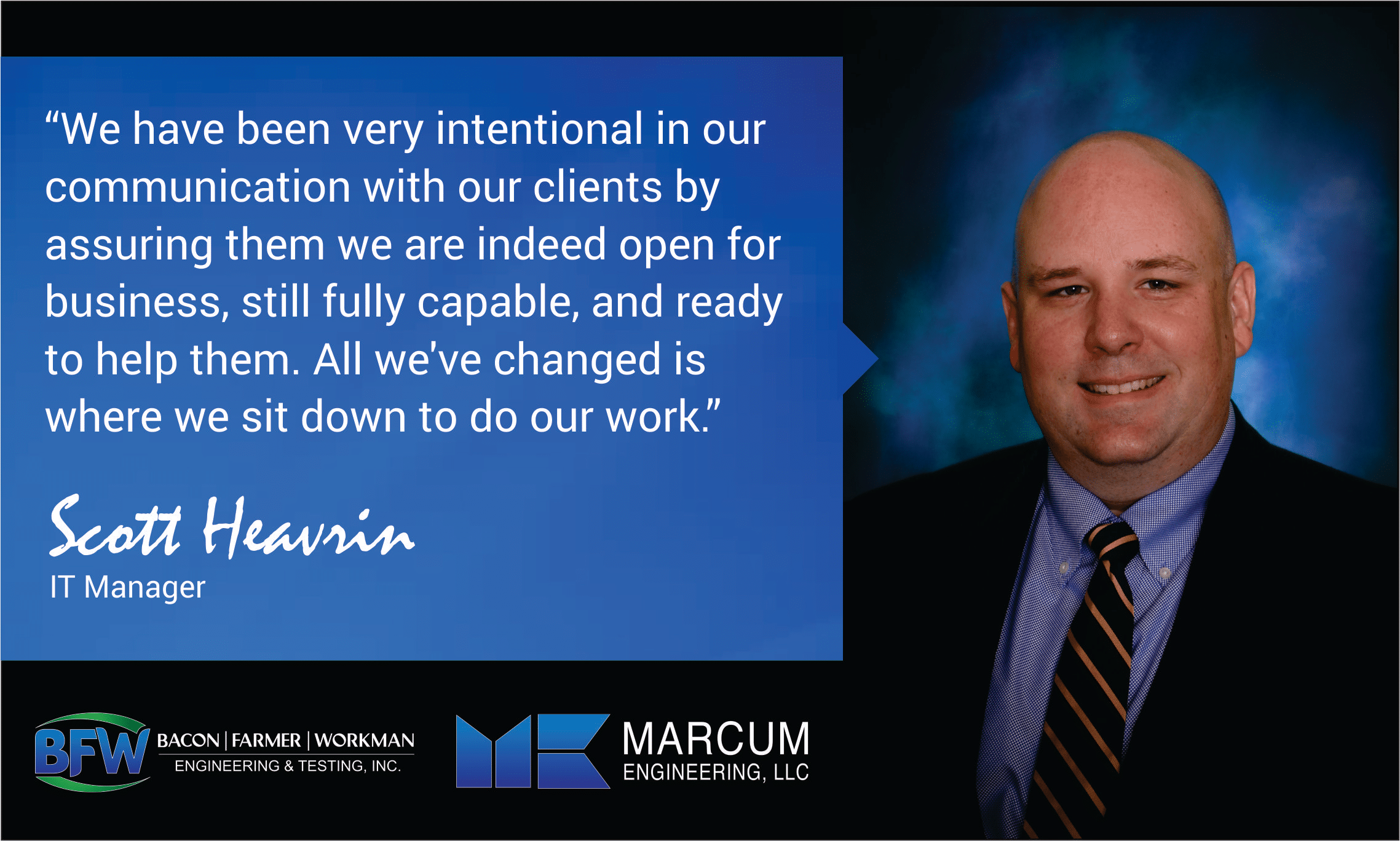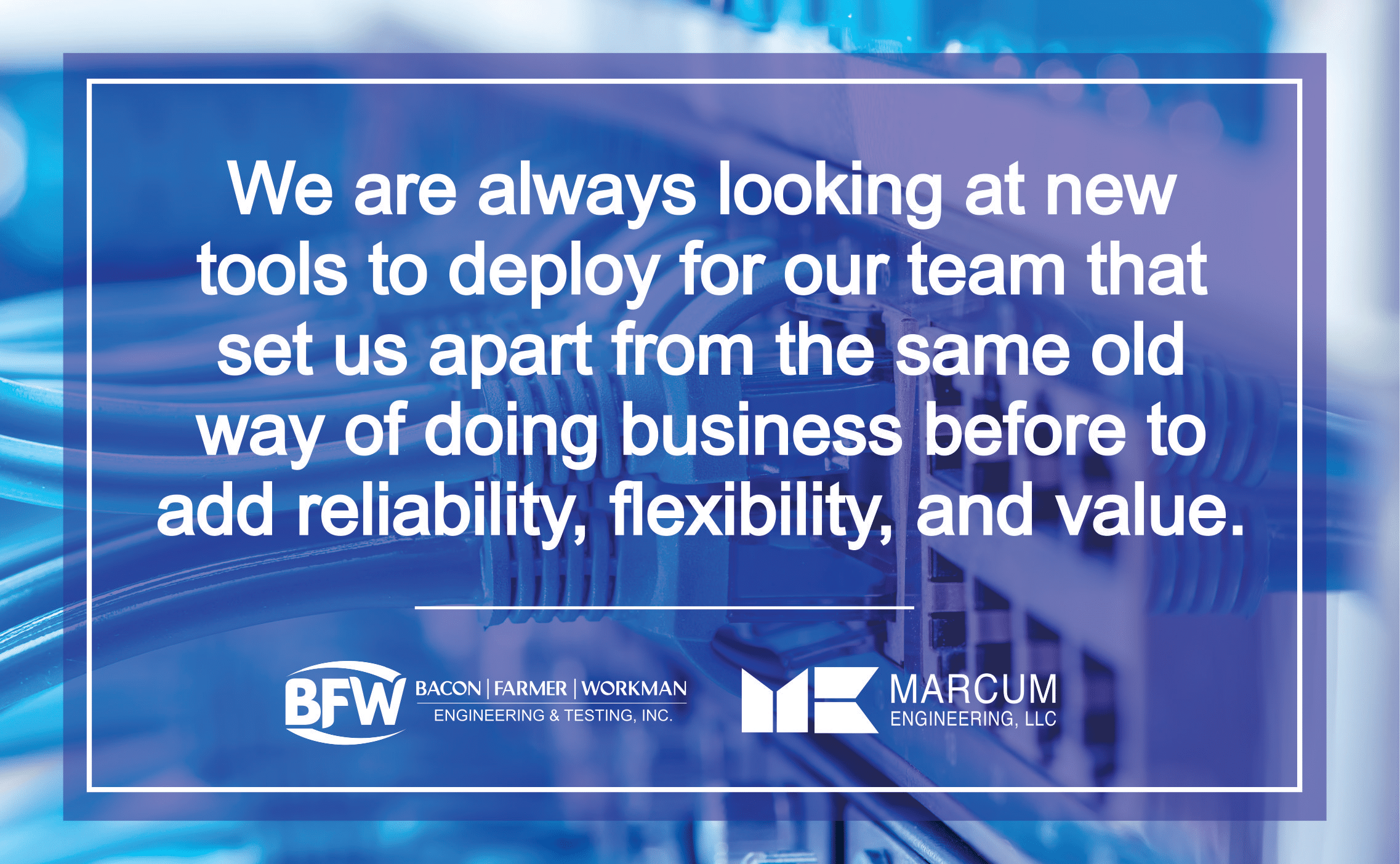“Same as Always”: How Our IT Kept Us Working
Many of the projects we have our hands in are considered “essential work”. However, the engineers and office workers that develop the designs, plans, and strategies for this work have no indispensable commitment to the physical office place at our firm. At BFW/Marcum, we think it’s a no-brainer that “office culture” is a huge component of what keeps us sharp but there is a time and a place for it.
Today, that time and place is somewhere in the near future. In these uncertain times, we know it’s more important to keep our people safe and healthy. While it was obvious what we had to do, the plan to execute a teleworking strategy for our employees was as sudden as it was challenging. Luckily, we have an IT Guy.
Scott Heavrin, Information Technology Manager
We figured Scott should speak for himself when explaining both his teleworking strategy, the challenges of that strategy, and how it ultimately unfolded. He was the figure most important to its success and we can say with satisfaction, everyone’s working at home right at this moment!
Scott helped us act quickly and without wasting any time. While many businesses still battled over the superficial details of their work-at-home plans, we were already signing into our Microsoft Teams meetings and toiling away at our workstations. So, we wanted to pick his brain about the situation.
How did it feel to be asked to convert an entire firm to remote work seemingly overnight?
“I follow world news closely even prior to this current situation so it was kind of in the back of my mind that something may force our hand on remote work. It wasn’t a surprise when Mark Workman told me early in March to prepare to deploy everyone by the end of the week.
However, it was certainly a surreal call to action. I appreciate his proactive and quick response to the situation, it afforded me time to get assets in position to make remote work possible.”
What were the greatest challenges to getting telework moving on such a large scale?
“We were already positioned well with a majority of our workflow being cloud-based. My biggest concern was how do I get everyone connected reliably to the internet. As I was making an early run of equipment for telework at our Springfield, IL office, I made the call to our Verizon business representative to place an order for “jet packs” (think of Wi-Fi routers that run on a cellular signal) to enable workers with inferior internet to be able to remote-in reliably from home. I knew even before we placed an order, that time was of the essence—we weren’t the only business in need of this technology and it quickly sold out. Luckily, we were early enough to acquire everything we needed.
Another challenge was how to rapidly deploy the software to our employee’s home computers that would then allow them to remote into their office work station. Much of the foundation for this type of process was already in place thanks to an existing contingency plan. The hidden obstacles were dealt with just like any obstacle at an engineering firm—you pivot, you improvise—you use your intuition and you keep your head up.”

What was the most surprising challenge that you didn’t anticipate?
“There was an immediate need to purchase more hardware from laptops, the aforementioned jet packs, computer monitors, etc. This whole thing became real when the limitations on shipping throughout the country became protracted due to the medical needs of the country taking priority, which affected the supply chain priority of our electronics.
The sudden delay in commonplace office electronics shifted my strategy regarding how to acquire some things to be able to get them in hand without causing too much of a production delay for us. That was unexpected but also another challenge we overcame with a little hard work and some searching.”
How do you get a bunch of engineers situated for working from home?
“You know, it seems to be a running joke about how engineers don’t adjust to change well, but I have to say, our folks have adapted so well!
Initially, I deployed a round of laptops for people to access their workstations from home through an encrypted remote control tool we use. The second wave consisted of people taking their workstations with them and accessing our network through an encrypted VPN client. Either method allows our team to seamlessly continue working as if they were sitting at their desk in the office.”
Beyond the firm’s employees, how are you helping clients navigate this sudden change in how you interface and communicate?
“We have been very intentional in our communication with our clients by assuring them we are indeed open for business, still fully capable, and ready to help them. All we’ve changed is where we sit down to do our work.”
Do you have any plans for telework in the future?
“I don’t think there is any denial at this point that telework will play some role as we move forward. The scale will be determined after this current situation, but the perception of telework is extremely different now, in a good way!
As we continue to grow, I’m always looking at new tools to deploy for our team that set us apart from the same old way of doing business before to add reliability, flexibility, and value. Cloud-based workstations are the next frontier and vendors can provide cloud-based virtual clients with computing power and graphics capability for 3D modeling that were not available even just last year. The development of this technology is huge, and I have plans to begin testing how to use this within our company this year.”

Any funny/interesting IT fails along the way?
“In one of our first meetings in Microsoft Teams, I was describing how the internet was bending to the load being placed upon it and to expect some glitches or delays.
As I looked at the screen, one of the attendees’ videos had frozen with this image of what appeared to be wide-eyed panic on their face. It was perfect timing and provided some levity for all of us.”
Ultimately, what is the role of IT amid our new uncertainty?
“There are times when it can be quiet on the IT front. Everything is humming along for the most part, then some situations pop up like the one we are in now. It is an epic task to convert a team to telework at the drop of a dime. This is where the IT staff must step up and prove themselves, both by having developed and by executing a sound contingency plan. Our role in IT, at its highest level, is to keep everyone productive. I try not to get lost in the gravity of the situation. I enjoy the problem solving and strategy components to these challenges.
Through recent years, we have taken much of our production into the cloud. These steps were taken with a lot of faith from our leadership based on my input that this is where we should go. Their trust in me and my decisions, while not fully understanding the technical back-end, played a huge role in our being able to pivot to telework. The fact that we were able to move to working from home in such a time of instability, I feel helped everyone feel a little more secure, especially when everything else around them felt so uncertain.”

Here’s to the Future
One thing we didn’t anticipate at the firm was how much we all wanted to feel as normal as possible in such an abnormal situation. We thank Scott for helping us find one way to slip away from the news and focus on our work. After all, the projects we’re still developing are a look into the near future, where we can anticipate a return to normalcy; call it engineering or call it hope!
If you need us, even if you just want to chat, we’re still working and we’ll answer, same as always.
